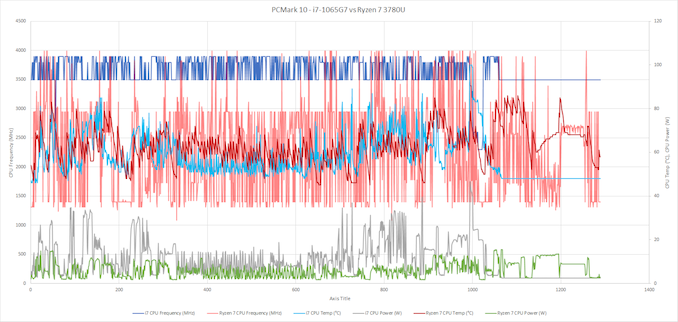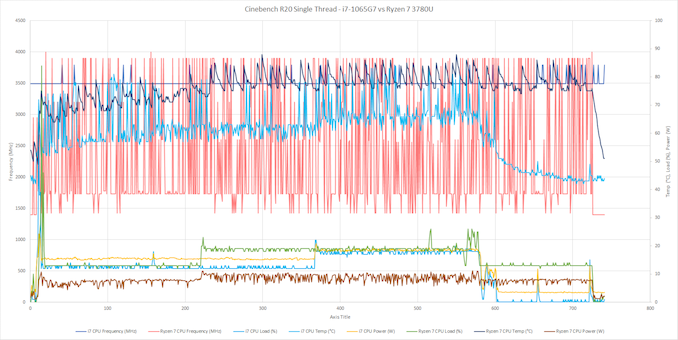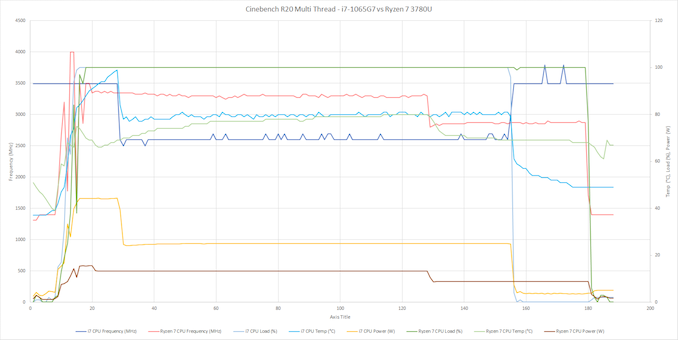The Microsoft Surface Laptop 3 Showdown: AMD's Ryzen Picasso vs. Intel's Ice Lake
by Brett Howse & Andrei Frumusanu on December 13, 2019 8:30 AM ESTBenchmark Analysis: Boost Behavior
Let’s dig into some of the testing to see how the systems responded during the benchmarks. We re-ran several of the tests while simultaneously monitoring the processor frequency, temperature, and power. Unfortunately for our comparison, the power polling results provided by our monitoring tools don’t seem to monitor the same power draw. The Intel power numbers are for the SoC package, but the AMD power numbers appear to be just the CPU cores, which is an unfortunate byproduct of testing two different platforms.
PCMark 10
PCMark 10 is a benchmark platform that attempts to simulate real-world tasks by running a variety of workflow, and the results were perhaps the most interesting of any of the benchmarks. There is a major discrepancy in how the AMD CPU behaved compared to the Intel. The Ice Lake platform kept the CPU frequency at a minimum of 3.5 GHz, with bursts to 3.9 GHz when under load. The Picasso processor was very aggressively switching from low frequency to high frequency, and was rarely indicating that it was over 3.0 GHz, but clearly demonstrating its higher peak frequency of 4.0 GHz in several locations. Both systems were fairly even in terms of CPU temperature, and Intel’s aggressive turbo levels were evident with peak power levels of 40 Watts for brief moments. The Ice Lake platform finished the benchmark about 200 seconds quicker than the Picasso system.
Cinebench R20 Single-Thread
We see somewhat similar results when only a single CPU core is loaded with the Picasso CPU frequency varying quite a bit. There’s also an average higher temperature on the AMD platform during this workload, and once again Ice Lake finishes the rendering quite a bit sooner thanks to its stronger CPU cores.
Cinebench R20 Multi-Thread
With all cores loaded the graph is considerably altered. Here the AMD processor is able to maintain a much higher frequency across its cores for much longer, while Intel's chip is only able to maintain 3.5 GHz for about 30 seconds before it runs out of headroom, dropping the cores down to around 2.6 GHz. But despite the lower frequency, the much higher IPC on Sunny Cove allows the Ice Lake platform to finish quite a bit sooner.













174 Comments
View All Comments
Andrei Frumusanu - Friday, December 13, 2019 - link
Correct. Between 3-5 hours each ST and MT.Fataliity - Friday, December 13, 2019 - link
"despite this being a 3.9 GHz chip, in single-threaded SPEC 2017, it managed to come very close to a 5.0 GHz Core i9-9900K with a massively higher TDP"This statement is contradictory. "Single-Threaded" Spec, then "Massively higher tdp" 9900k is 8 cores. which reflects the TDP. Single-Thread is one core, which is completely different. If you scale up the frequency / wattage graph, a Ice Lake 3.5GHz at 8 cores would be about 100 watts. Which im pretty sure is really close to a 9900k off the top of my head. Except this is at 3.5 and 9900k is hitting 5GHz.
tipoo - Friday, December 13, 2019 - link
Shame AMD didn't have 7nm Zen 2 for mobile ready in time for this. Maybe that's when the partnership will make more sense, until then I wish the consumer 15" was also Ice Lake.s.yu - Friday, December 13, 2019 - link
The difference is too great. This is almost an i3 to i7 comparison, while the price difference is confusingly little. Though the Intel version could be hard to acquire, whoever's interested in this model should aim for the Intel version, even through unofficial channels.eastcoast_pete - Friday, December 13, 2019 - link
Interesting! Guess Chipzilla is (still) king of the hill in mobile; quite impressive, as this IL i7 even comes close to desktop i7 speeds. AMD really needs to get 7 nm Zen2 or Zen2+ into mobile APUs pronto - they're leaving a lot of money on the table. Now is the time, before chipzilla gets their manufacturing problems worked out!MBarton - Monday, December 30, 2019 - link
Less impressive when you consider the amount of money and number of defective CPU's required by Intel fabs to get to this point. When you factor in how much money Intel has dumped into their 10nm process over the last decade the money they're making off of 10 nm is sad.Consumer1 - Friday, December 13, 2019 - link
Interesting to me is the slow speed of the memory with the Ryzen. Ryzen does better with faster memory. To bad we can't equalize the memory to see the effect.Dustin Sklavos - Friday, December 13, 2019 - link
I would never in a million years accuse AnandTech writers of being shills.That said, you guys didn't notice the Ice Lake CPU was being allowed to peak and sustain a solid 8W higher than the Ryzen CPU was?
Yes, even with the higher ceiling on Ice Lake, it's able to bring its idle draw down way lower than Ryzen's, so the bursty nature of garden variety on-battery web surfing is going to heavily favor Ice Lake.
But plugged in, full bore benchmarks, the Ice Lake unit is at a clear advantage for power budget and that's concerning. It's not really as fair a fight when the Ryzen is being kneecapped, and while I don't think it would change the overall results, I *do* think the CPU tests wouldn't be the bloodbath that they are, and the GPU tests (and especially gaming tests) would be a clearer cut win for AMD.
Brett Howse - Saturday, December 14, 2019 - link
I mentioned this in the text but the data logging tool is monitoring CPU core power on Ryzen and SoC package power on Core so the data isn't 100% comparable just due to what each company exposes to be monitored. If you look at the CPU temperatures on the Cinebench R20 test as an example the CPU temperatures are very similar so I don't think the power budget is as far off as you'd think, although Intel is pretty aggressive with boost.Fataliity - Saturday, December 14, 2019 - link
Zen+ APU is also a 216mm die vs Intel's 125mm die. So it has double the surface area, which should mean almost double the heat dissipation (maybe less). So Intel's numbers being twice as high in power draw actually makes sense when you consider the area that is dissipating the heat.